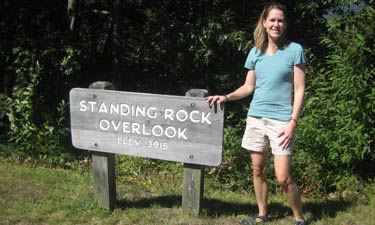 In the 1990s, the U.S. Centers for Disease Control and Prevention (CDC) began tracking the rise of adult obesity by state in the United States and the map that resulted from that data is as frightening as it is illuminating. The map on the CDC website quantifies the rapid transformation of the country as obesity incidences spread like a disease. In 1990, a serene sea of blue depicts obesity rates below 19 percent coast to coast. Steadily, year by year, the map morphs into a garish 2010 patchwork of tan, orange, and dark red—tracing the state-by-state chronology of our national obesity epidemic.
In the 1990s, the U.S. Centers for Disease Control and Prevention (CDC) began tracking the rise of adult obesity by state in the United States and the map that resulted from that data is as frightening as it is illuminating. The map on the CDC website quantifies the rapid transformation of the country as obesity incidences spread like a disease. In 1990, a serene sea of blue depicts obesity rates below 19 percent coast to coast. Steadily, year by year, the map morphs into a garish 2010 patchwork of tan, orange, and dark red—tracing the state-by-state chronology of our national obesity epidemic.
Dr. Heidi Blanck, Chief of Obesity Prevention and Control at the CDC, is part of the division that tracks and presents the hard data of America’s worsening obesity problem. Blanck began her career in nutrition from a background in molecular biology—and, over time, became fascinated by (and earned a doctorate in) the behavioral and environmental aspects of nutrition. “I wanted to understand people’s relationships with food and places where eating occurs,” she says, “not just the molecular science of nutrition.”
Blanck and her staff study the environments and settings in which nutrition choices are made—physical, social, and psychological—and strategize how to “make the healthy choice the easy choice.” It is an approach that recognizes not only the aggregate public health impact of individuals’ choices—but also the opportunities afforded or denied by the built and cultural environments.
“We, the folks at CDC,” Blanck adds, “are the ones who assess and send out information on acute epidemics. The chronic diseases [like obesity] haven’t always received the attention.” Therefore, Blanck has been eager for chances to partner with the agencies and institutions (such as schools, child care, worksites, and parks) that serve a broad cross-section of the public. The goal is to apply obesity prevention research—and to adapt some of the tools CDC has developed—to improve Americans’ access to good nutrition.
A recent “epi-aid” (epidemic assistance) request from the Department of the Interior has given Blanck and her staff an unprecedented opportunity to assess the nutrition and drinking water options available in national parks. The request has resulted in pilot and national evaluation that can have significant bearing on food and beverage offerings made available by park agencies at all jurisdictional levels.
Whether a park visitor is in the park for an afternoon or a family vacation, parks can take leadership in promoting healthy eating, Blanck says. And the changes she and her team recommend involve more creative thinking than financial investment.
Inviting concessionaires and vending machine suppliers into brainstorming sessions can lead to cost-neutral improvements, Blanck says. She cites recent discussions with vendors to consider reducing fruit-juice portion sizes in children’s meals, reducing the added sugar in flavored milks, and increasing the amount of whole grains in buns. And vending machine suppliers, she reminds, have a stake in satisfying both end-users and the facilities that host them.
Drinking water is often overlooked when park facilities examine the nutritional options they offer the public. “We are looking carefully at water equity,” she says. “It’s not enough to tell people to reduce sugary drinks. You have to make good drinking water available. And we think the public has a right to good drinking water that is also free.”
So Blanck and her team, in their work with the National Park Service, examined water fountains and other sources of drinking water carefully. Were the fountains clean and appealing to drink from? Did they dispense cold water? Were they designed to allow a user to fill a water bottle easily? They used a smart phone app to assess water fountain locations. The same technology could be used in the future to create maps or apps helping park visitors find the nearest water fountains, she says.
“Parks offer so much and bring in so many different health aspects,” Blanck says. “And we’ve only begun to look at some of the ways that healthy foods might lead park visitors to stay longer.” Noting the inter-relationship between nutrition and physical activity, she speculates that longer visits with better nourishment might just mean longer periods of families enjoying physical activity together. “This is not the same as just going out and walking on a track,” she concludes. “With parks, it’s about the whole environment. The atmosphere you are creating and the choices you are offering.”
And, if Blanck’s obesity research moves into action, erasing the reds and oranges from that national map will come from an abundance of healthy, easy, appealing options—thoughtfully integrated into the settings where people live and recreate.

